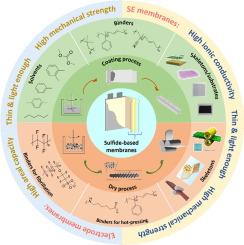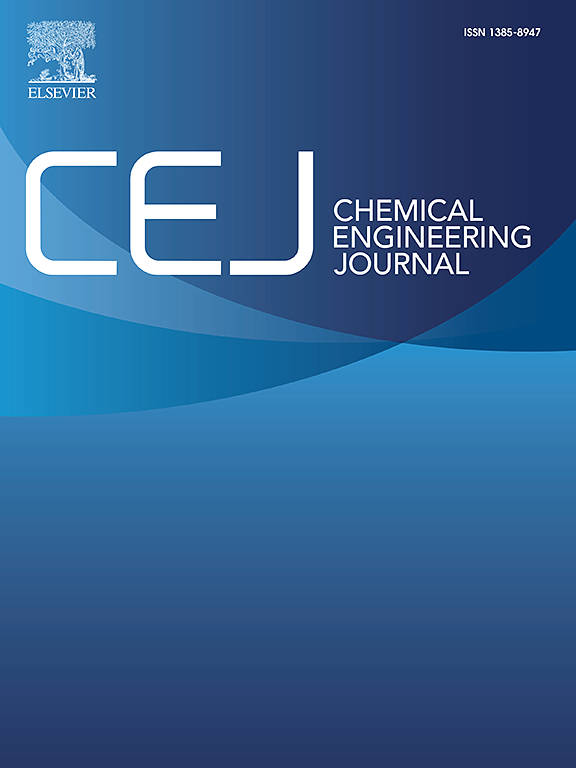全固态锂电池用硫化物基固体电解质和电极膜
IF 13.3
1区 工程技术
Q1 ENGINEERING, CHEMICAL
引用次数: 0
摘要
硫化物基全固态锂电池(ASSLBs)已经引起了学术界和工业界的极大关注,因为它有潜力解决传统锂离子电池(lib)有限的能量密度和安全问题,同时受益于硫化物固体电解质(SEs)的高离子导电性和延展性。开发硫化物SE膜和含硫化物复合电极膜对于最大限度地利用现有的LIB制造设备和技术在ASSLB生产中至关重要。然而,与硫化物基原型电池的快速发展相比,硫化物基膜和相应的袋状电池的进展相对缓慢。这篇综述旨在通过总结硫化物基膜的发展来弥补这一差距,为研究人员提供宝贵的资源。我们首先讨论硫化se的发展和性质。然后,我们详细介绍了制备硫化物基膜的各种策略,包括溶剂辅助涂层工艺(重点是溶剂、粘合剂和骨架/衬底的选择)、无溶剂干燥工艺(纤维和热压的粘合剂选择,以及骨架的使用)和其他制造方法。最后,我们分析了硫化物基膜及其袋状电池的化学和物理要求,并对硫化物基膜和ASS袋状电池的挑战和前景进行了展望。本文章由计算机程序翻译,如有差异,请以英文原文为准。


Sulfide-based solid electrolyte and electrode membranes for all-solid-state lithium batteries
Sulfide-based all-solid-state lithium batteries (ASSLBs) have garnered significant attention from both academia and industry due to their potential to address the limited energy density and safety concerns of conventional Li-ion batteries (LIBs), while benefiting from the high ionic conductivity and ductility of sulfide solid electrolytes (SEs). Developing sulfide SE membranes and sulfide-containing composite electrode membranes is crucial for maximizing the use of existing LIB manufacturing equipment and technologies in ASSLB production. However, compared to the rapid advancements in sulfide-based prototype cells, progress in sulfide-based membranes and corresponding pouch cells has been relatively slow. This review aims to bridge that gap by summarizing the evolution of sulfide-based membranes as a valuable resource for researchers. We begin by discussing the development and properties of sulfide SEs. Then, we elaborate on the various strategies for preparing sulfide-based membranes, including solvent-assisted coating processes (focusing on solvent, binder, and skeleton/substrate selection), solvent-free dry processes (binder selection for fibrillation and hot-pressing, as well as the use of skeletons), and other fabrication methods. Finally, we analyze the chemical and physical requirements for sulfide-based membranes and the resulting pouch cells, and provide an outlook on the challenges and prospects for sulfide-based membranes and ASS pouch cells.
求助全文
通过发布文献求助,成功后即可免费获取论文全文。
去求助
来源期刊

Chemical Engineering Journal
工程技术-工程:化工
CiteScore
21.70
自引率
9.30%
发文量
6781
审稿时长
2.4 months
期刊介绍:
The Chemical Engineering Journal is an international research journal that invites contributions of original and novel fundamental research. It aims to provide an international platform for presenting original fundamental research, interpretative reviews, and discussions on new developments in chemical engineering. The journal welcomes papers that describe novel theory and its practical application, as well as those that demonstrate the transfer of techniques from other disciplines. It also welcomes reports on carefully conducted experimental work that is soundly interpreted. The main focus of the journal is on original and rigorous research results that have broad significance. The Catalysis section within the Chemical Engineering Journal focuses specifically on Experimental and Theoretical studies in the fields of heterogeneous catalysis, molecular catalysis, and biocatalysis. These studies have industrial impact on various sectors such as chemicals, energy, materials, foods, healthcare, and environmental protection.
 求助内容:
求助内容: 应助结果提醒方式:
应助结果提醒方式:


